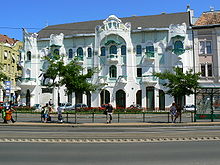KEDITART
Szeged szép épületeinek saját magam által fotografált, nekem legjobban tetsző épületei.
2018. december 10., hétfő
2018. december 6., csütörtök
2011. november 9., szerda
History
Szeged and its area have been inhabited since ancient times. Ptolemy mentions the oldest known name of the city: Partiscum. It is possible that Attila, king of the Huns had his seat somewhere in this area. The name Szeged was first mentioned in 1183, in a document of King Béla III.During the Mongol invasion the town was destroyed and its inhabitants fled to the nearby swamps, but they soon returned and rebuilt their town. In the 14th century, during the reign of Louis the Great, Szeged became the most important town of Southern Hungary, and – as the Turkish armies got closer to Hungary – the strategic importance of Szeged grew. King Sigismund of Luxembourg had a wall built around the town. Szeged was raised to free royal town status in 1498.
Szeged was first pillaged by the Turkish army on 28 September 1526, but was occupied only in 1543, and became an administrative centre of the Ottomans (see Ottoman Hungary). She was a sanjak centre at first in Budin Eyaleti (1543–1596), after in Eğri Eyaleti. The town was freed from Turkish rule on 23 October 1686, and regained the free royal town status in 1715. In 1719 Szeged got its coat of arms (still used today) from Charles III. During the next years Szeged grew and prospered. Piarist monks arrived in Szeged in 1719 and opened a new grammar school in 1721. They also held scientific lectures and theatrical plays. However, these years brought not only prosperity and enlightenment; between 1728 and 1744 witch trials were frequent in the town; in 1728-29, the perhaps largest Hungarian witch trial was held here. In 1720, the population of the city totalled 193 households, of which 99 were Serbian.
Szeged is known as the home of paprika, a spice made from dried, powdered capsicum fruits. Paprika arrived in Hungary in the second half of the 16th century as an ornamental plant. About 100 years later the plant was cultivated as a herb, and paprika as we know it was born.[2] Szeged is also famous for their Szekelygulyas, a goulash made with pork, sauerkraut and sour cream.[3] And also famous for their Halászlé, fish soup made of carp and catfish.
The citizens of Szeged played an important part in the Hungarian Revolution of 1848. Lajos Kossuth delivered his famous speech here. Szeged was the last seat of the revolutionary government in July 1849. The Habsburg rulers punished the leaders of the town, but later Szeged began to prosper again, the railway reached it in 1854, and the town got its free royal town status back in 1860. Mark Pick's shop – the predecessor of today's world famous Pick Salami Factory – was opened in 1869.
Today the inner city of Szeged has beautiful buildings and wide avenues. This is mainly due to the great flood of 1879, which literally wiped away the whole town (only 265 of the 5723 houses remained and 165 people died). Emperor Franz Joseph visited the town and promised that "Szeged will be more beautiful than it used to be". He kept his promise. During the next years a new, modern city emerged from the ruins, with palaces and wide streets.
[edit] During the twentieth century
After the first World War Hungary lost its southern territories to Romania and Serbia, thus Szeged became a city close to the border, and its importance lessened, but as it took over roles that formerly belonged to the now lost cities, it slowly recovered. The University of Kolozsvár (now Cluj-Napoca, Romania) moved to Szeged in 1921 (see University of Szeged). In 1923 Szeged took over the role of episcopal seat from Temesvár (now Timişoara, Romania). It was briefly occupied by Romanian army during Hungarian-Romanian War in 1919.Szeged suffered a lot during the World War II, 6,000 inhabitants of the city were killed, the Jewish citizens were confined to ghettos, then taken to death camps, and the Soviet army occupied the city in 1944. During the Communist era Szeged became a centre of light industry and food industry. In 1965 oil was found near the city; the area now satisfies 67% of the country's oil demand.
In 1962 Szeged became the county seat of Csongrád. Whole new districts were built, and lots of nearby villages (e.g. Tápé, Szőreg, Kiskundorozsma, Szentmihálytelek, Gyálarét) were annexed to the city in 1973 (as was a tendency during the Communist era).
Today's Szeged is an important university town and a popular tourist attraction.
[edit] Geography
Szeged is situated near the southern border of Hungary, just to the south of the mouth of the Maros River, on both banks of the Tisza River.[edit] Climate
Szeged's climate is transitional between oceanic (Köppen Cfb) and continental (Köppen Dfb), with cold winters, hot summers, and fairly low precipitation.| [hide]Climate data for Szeged |
|---|
2011. február 13., vasárnap
2010. november 5., péntek
Feliratkozás:
Bejegyzések (Atom)





